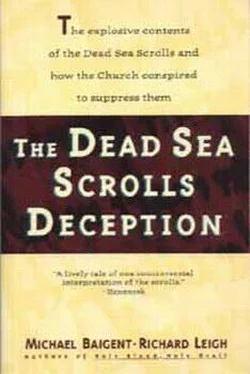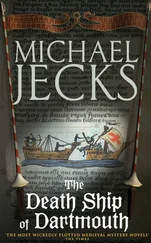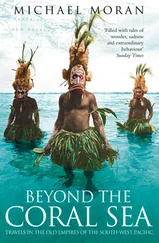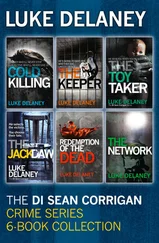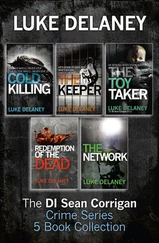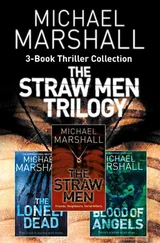It seems clear that, by this time, Allegro was becoming nervous. On 6 March, he wrote to another member of the international team, Frank Cross, who had just been offered an appointment at Harvard University: ‘I am awfully pleased about Harvard. Not only because this Christianity business is played out. ‘ 20But in the same letter, he admitted that the barrage of criticism was wearing him down and that he was feeling, both physically and mentally, ‘at the end of my tether’. Certainly he had no desire to see the publication of a letter which alienated him publicly from the other members of the team and, by so doing, impugned his credibility.
By now, of course, it was too late. On 16 March 1956, the letter duly appeared in The Times, signed by Strugnell as well as by Fathers de Vaux, Milik, Skehan and Starcky, most of the team’s ‘big guns’:
There are no unpublished texts at the disposal of Mr Allegro other than those of which the originals are at present in the Palestine Archaeological Museum where we are working. Upon the appearance in the press of citations from Mr Allegro’s broadcasts we are unable to see in the texts the ‘findings’ of Mr Allegro.
We find no crucifixion of the ‘teacher’, no deposition from the cross, and no ‘broken body of their Master’ to be stood guard over until Judgment Day. Therefore there is no ‘well-defined Essenic pattern into which Jesus of Nazareth fits’, as Mr Allegro is alleged in one report to have said. It is our conviction that either he has misread the texts or he has built up a chain of conjectures which the materials do not support. 21
To publish this sort of accusation — especially in a letter to The Times — is remarkable behaviour. It patently reflects a conclave of academics ‘ganging up’ on one of their own members. Forced on to the defensive, Allegro replied with a letter to The Times of his own, which explained and justified his position:
In the phraseology of the New Testament in this connection we find many points of resemblance to Qumran literature, since the sect also were looking for the coming of a Davidic Messiah who would arise with the priest in the last days. It is in this sense that Jesus ‘fits into a well-defined messianic (not “Essenic” as I was wrongly quoted…) pattern’. There is nothing particularly new or striking in the idea. 22
It is a reasonable enough statement, a legitimate correction of an important misquotation. It also indicates how eager Allegro’s colleagues were to ‘jump on him’, to find an excuse for discrediting him. In any case, Allegro added, ‘It is true that unpublished material in my care made me more willing to accept certain suggestions made previously by other scholars on what have appeared… to be insufficient grounds.’ 23
The bickering and ill-feeling continued until finally, on 8 March 1957, Allegro wrote angrily to Strugnell:
You still do not seem to understand what you did in writing a letter to a newspaper in an attempt to smear the words of your own colleague. It was quite unheard of before, an unprecedented case of scholarly stabbing in the back. And, laddie, don’t accuse me of over-dramatising the business. I was here in England… Reuters’ man that morning on the ‘phone to me was classic: ‘But I thought you scholars stuck together!…’ And when it was realised that in fact you were quoting things I never even said, the inference was plain. This letter was not in the interests of scholarly science at all, but to calm the fears of the Roman Catholics of America… And what it all boiled down to was that you guys did not agree with the interpretation I put on certain texts — where I have quite as much chance of being right as you. Rather than argue it out in the journals and scholarly works, you thought it easier to influence public opinion by a scurrilous letter to a newspaper. And you have the neck to call it scholarship. Dear boy, you are very young yet, and have much to learn. 24
As we have already noted, Allegro was the first of the international team to publish all the material entrusted to his charge. He remains the only one to have done so. John Strugnell, on the other hand, in accordance with the ‘go-slow’ policy of the team, has published virtually nothing of the substantial materials at his disposal. The only major work to which he did address himself, entitled ‘Notes in the Margin’, comprises 113 pages of criticism of Allegro, which Eisenman labels a ‘hatchet-job’.
In the meantime, the damage had been done. The letter to The Times signed by de Vaux and three other ecclesiastics effectively gave free rein to the Catholic propaganda machine. Opprobrium and vilification intensified. In June 1956, for example, a Jesuit commentator published in the Irish Digest an article entitled ‘The Truth about the Dead Sea Scrolls’. He attacked Wilson, Dupont-Sommer and, especially, Allegro. He then went on to make the extraordinary statement that the ‘Scrolls add surprisingly little to our knowledge of the doctrines current among the Jews from, say, 200 bc to the Christian era’. 25He concluded in positively inflammatory fashion: ‘It was not from such a sect that “Jesus learned how to be Messiah”… Rather, it was from soil such as this that sprang the thorns which tried to choke the seed of the Gospel.’ 26Allegro was now being portrayed not merely as an erring scholar, but as a veritable Antichrist.
While this controversy was still raging around him, Allegro was already becoming involved in another. The new bone of contention was to be the so-called ‘Copper Scroll’, found in Cave 3 at Qumran in 1952. As we have noted, the two fragments that made up the ‘Copper Scroll’ remained unopened for three and a half years. Speculation was rife about their contents. One researcher attempted to read the indentations showing through the copper and visible on the outside of the roll. It seemed to say, he suggested, something about treasure. This suggestion elicited a salvo of derision from the international team. It proved, however, to be quite correct.
In 1955, a year before his public dispute with his colleagues on the international team, Allegro had discussed the problem of the ‘Copper Scroll’ with Professor H. Wright-Baker of Manchester College of Technology. Wright-Baker devised a machine that could slice the thin copper into strips, thus rendering the text legible. The first of the two fragments was accordingly sent to Manchester, in Allegro’s care, in the summer of 1955. Wright-Baker’s machine performed its task, and Allegro quickly embarked on a translation of what had been revealed. The contents of the fragment proved so extraordinary that he kept them initially wholly to himself, not even divulging them to Cross or Strugnell, both of whom wrote to beg for details. His reticence cannot have improved his relations with them, but Allegro was in fact waiting for the second fragment of the scroll to arrive in Manchester. Any partial or premature disclosure, he felt, might jeopardise everything. For what the ‘Copper Scroll’ contained was a list of secret sites where the treasure of the Temple of Jerusalem was alleged to have been buried.
The second fragment was received in Manchester in January 1956. It was quickly sliced open and translated. Both fragments, along with accompanying translations, were then returned to Jerusalem. Only then did the real delays begin. De Vaux and the international team were worried about three things.
Their first concern was valid enough. If the contents of the scroll were made public and stories of buried treasure began to circulate, the Bedouin would be digging up the entire Judaean desert, and much of what they found might disappear for ever or elude scholarly hands and slip into the black market. Something of this sort was, in fact, already occurring. On discovering or learning of a potentially productive site, the Bedouin would set up a large black tent over it, loot it, pick it clean and sell their plunder privately to antique dealers.
Читать дальше
